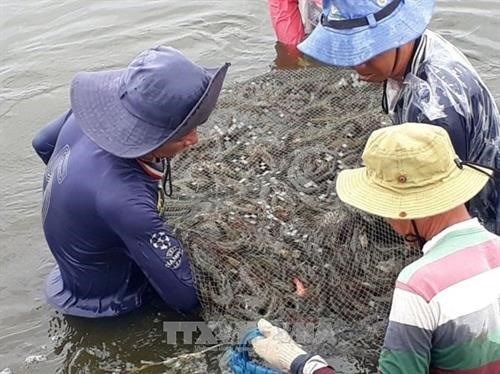Under the highly profitable model, farmers use the same field to raise blue-legged prawns and white-legged shrimps in the dry season, while rice is cultivated in the rainy season.
Pham Van Hau, Vice Chairman of the Vinh Thuan district People’s Committee, said that breeding prawns lasts for six months and shrimps three months.
    |
 |
|
Vinh Thuan district in the Mekong Delta province of Kien Giang plans to expand the shrimp cultivation area to 10,000ha. |
With such a schedule, farmers can harvest three crustacean crops and one rice crop a year.
The model provides an average profit of about VND 300 million (USD 13,200) per ha per year, he said.
The district plans to expand the model in Vinh Binh Nam, Vinh Binh Bac and Binh Minh communes, which are located along the Cai Lon River, and in Tan Thuan commune.
The shrimps bred under this model are considered “clean” because farmers do not use chemicals. In addition, the quality of the field soil improves and provides natural food for the shrimp.
Also, farmers no longer have to worry about selling their products as traders come to their fields to buy the shrimps.
Vo Van Sua, who has 3ha of land in Vinh Binh Bac commune, said he earns a profit of more than VND 900 million (USD 36,600) a year from shrimps and rice. In the past, his family bred black tiger shrimps and did not always earn a profit.
To enhance efficiency, the district will expand the market for blue-legged prawns as farmers are more willing to switch to the model when there is a stable outlet.
“Under the district’s agricultural restructuring plan, the district is developing the rotation model, but many farms are still breeding only shrimp,” he said. This could lead to polluted water resources and soil degradation, which could damage farms.
This year, the district will register a collective brand for its blue-legged prawns and rice planted under the shrimp-rice rotating model, he said.
Shrimps and rice are two key agricultural products in the Mekong Delta district of Vinh Thuan, where the soil is affected by aluminum and saltwater intrusion.
The district’s blue-legged prawns are sold domestically and also exported to Cambodia.
Last year, the district bred about 23,880ha of various kinds of shrimps with a total yield of about 12,580 tons, up 20 percent against 2016.
Of the figure, blue-legged prawns accounted for 5,551 tons, and white-legged shrimps and black tiger shrimps the rest.
Source: VNA